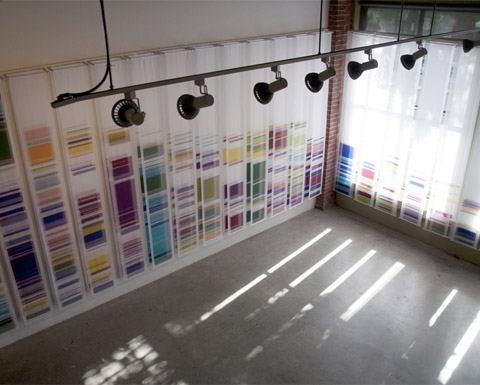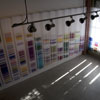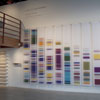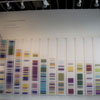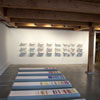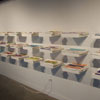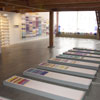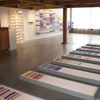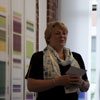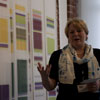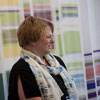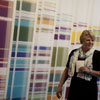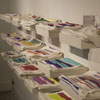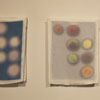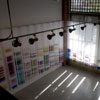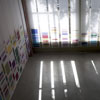Chromosome Painting, and works from 2009-12
WORK IN EXHIBITION
CHROMOSOME PAINTING, 2012
Window and wall installation spanning 32’
Jacquard dye and dye sublimation, printed on ultra-sheer and sheer silk
Panels, 14 x 108”
CHROMOSOME LIGHT BOXES 1-22 AND X, 2012
Silk Crepe de Chine, Jacquard dyed and printed. Silk panels 13 x 69”
Light Boxes: fir, plexiglass, fiber optic lights
14 x 70 x 3 ¾ “
CHROMOSOME PAINTINGS 1-22 AND X, 2012
Silk Crepe de Chine, Jacquard dyed and printed. Silk panels 13 x 69”
The silk panels were produced in a limited edition of 10 and will be sold to raise funds for the University of Washington Cancer Genetic Medicine Clinic for education and research, and for those who have cancer and are unable to afford medical diagnosis and treatment. Additionally, the funds will benefit those who have cancer and would like to bank their DNA so their children and extended family can benefit from genetic testing. A list of each chromosome and corresponding Cancer markers is listed below.
CHROMOSOME 1. Prostate Cancer 2. Ovarian Cancer 3. Colon Cancer 4. Leukemia 5. Gastric Cancer 6. Ovarian Cancer 7. Colon Cancer 8. Hepatocellular Cancer 9. Melanoma 10. Prostate Cancer 11. Bladder Cancer 12. Oral Cancer 13. Pancreatic Cancer 14. Lymphoma 15. Hodgkin’s Lymphoma 16. Breast Cancer – Lobular 17. Breast Cancer 18. Pancreatic Cancer 19. Leukemia T-cell Acute 20. Colin Cancer 21. Breast Cancer 22. Leukemia X. Testicular Cancer
DNA MICROARRAY, 2012
Cotton, silk with Jacquard dye
8’ x 7’
DNA MICROARRAY, 2011
3 small sample color tests
Silk laser printed
8” x 10”
DNA MICROARRAY, 2010
2 prototype boxes
Jacquard dye and dye sublimation, printed on ultra-sheer and sheer silk 24” x 24”
A COLLABORATION: Genevieve Gaiser Tremblay, Curator
In 2009, artist Geraldine Ondrizek, Senior Genetic Counselor and Co-Director of UW Genetic Medicine Clinic, Robin Bennett, and I (Genevieve Tremblay), as a public scholar, collaborated to bring together art and medical science. This culminated in 2011 with a public art commission created by Ondrizek for the UW Medical Center to commemorate 50 years of Medical Genetics at the University of Washington. Geraldine Ondrizek is a research-based artist and Professor at Reed College. Her work ignites interest and inquiry about the influence of cancer and other diseases on both individuals and entire families. She relies heavily on scientific inquiry, focusing on documenting biological specimens and exploring systems of categorization. She works closely with genetic scientists to trace ethnic identities, portray life spans, and depict genetically inherited conditions. Robin Bennett, one of the most prominent genetic counselors in the nation, teaches human genetics at the UW Medical School. She pioneers genetic counseling practices that have become standard worldwide. As a public scholar, I integrate research, teaching, service, and public engagement in my curatorial practice. The three of us felt compelled to work together within our own disciplines to make genetic information more accessible, more visible, and better understood.
Bennett granted Ondrizek access to a team of groundbreaking genetic researchers, which inspired Ondrizek to create new works that forged visual, scientific, and metaphorical discoveries. The works featured in this exhibit explore the nature of our bio-cultural differences and similarities. Ondrizek assembled a rich collection of images from research done by prominent medical geneticists, including, UW Medical Genetics founder Arno Motulsky, and Peter Byers.
In the three bodies of work featured in this exhibit: Chromosome 17, DNA Microarray, and Chromosome Paintings, Ondrizek meshes the material semiotics of cloth and culture with the complex and colorful language of genetic data. She leverages humble craft methods associated with domesticity to create textile portraits, color patterns and sequences that metaphorically portray what she calls “our coats of many colors.” Her deep inquiry into the more scientific realm of human identity invites us along and delivers not only exquisite aesthetic interpretations, but also a genetic literacy primer to inspire our own self-discoveries.
Inheritance. Robin Bennett, Senior Genetic Counselor
Genetics touches all of us. We all take pride in our heritage, and we may boast about characteristics that “run in the family.” Conversely, concerns about family diseases that may be inherited can also lead to feelings of anxiety, guilt, fear of the unknown, or even relief if we discover that a particular disease is not strongly inheritable, or we feel empowered to take preventive actions against a disease. The collaboration between myself, Ondrizek, and the University of Washington medical genetics physicians and researchers shows the beauty in our DNA and brings this art and genetic science to the public. This work provides an opportunity for dialogue between geneticists and the public to help allay fears and misconceptions related to genetics. Information about family history in conjunction with genetic testing can provide important information at many times throughout the lifespan: in planning pregnancies, in newborns and children, throughout adolescence and in adulthood. For families where DNA testing may not be as informative yet, the option of banking DNA (from blood or saliva) can be a gift to future generations.
WORKS FROM 2009-2012, Geraldine Ondrizek
This exhibition at the Kirkland Arts Center, curated by Genevieve Gaiser Tremblay, allows me to present three bodies of work generated from my two-year collaboration with Robin Bennett and the Division of Medical Genetics at the University of Washington.
First are prototypes made for the 2011 University of Washington commission Chromosome 17 and the piece created for the Portland Art Museum, Case Study. Both works use the National Center for Biotechnical Information (NCBI) database of the human genome as a resource to artistically map scientifically derived gene sequences. The second work, DNA Microarray, located on the balcony, is formed from several large silk panels imprinted with the image of a DNA microarray. A microarray is a set of tiny DNA “spots”: small chunks of DNA sequences known as “probes” that fasten to a glass or silicon chip. The probes identify target sequences of DNA, which are easily seen via fluorescence or chemiluminescence as red, yellow, green, and blue dots that glow like a grid of stars in the night sky.
The third body of work, Chromosome Paintings, which spans the front window and wall, was made specifically for the Kirkland Arts Center. Chromosome Paintings is based on the image of a synteny map, a colorful, striped array that compares gene sequences and chromosomes among species. The long silk panels, each printed with human chromosome maps, are arresting displays of fluorescent color arranged to stunningly depict chromosomal comparisons. Fuchsia neighbors chartreuse, purple sidles up to orange, soft grays mingle with blues. These juxtapositions spur the eye to dart between various color combinations and arrangements.
The origins of the word ‘chromosome’ comes from Greek khroma (“color”) + soma (“body”)’ These panels, literally made up of different color combinations, physically manifest the “color bodies” (or chromosomes). Chromosome paintings as representations of scientific data are optically stunning and will generate dialogues about vibrancy, complements, contrasts, and tonal ranges of the color combinations, which parallel genetic variance, anomalies, and similarities. The technique of chromosome painting, also known as “fluorescence in situ hybridization,” can detect chromosomal abnormalities like translocations and structural alterations associated with various diseases. For example, chromosome 19 carries a gene implicated in leukemia. With these disease associations in mind, each panel is labeled with a type of cancer correlated with a genetic marker present on the chromosome.
Chromosome Light Boxes showcases each chromosome synteny map printed on white silk within a light box so the colors glow from within. These panels are marked with the genetic anomalies linked to different types of cancer found on each gene. The silk panels were also produced in a small edition of 10 each and will be sold to raise funds for the University of Washington Cancer Genetic Medicine Clinic for education and research, and specifically for those who have cancer and are unable to afford medical diagnosis and treatment. Additionally, the funds will benefit those who have cancer and would like their DNA to be preserved so their children and extended family can benefit from genetic testing will be given the chance to bank their DNA. Credits: Sewing and fabrication assistance, Camille Charlier. Chromosome Painting, Figure 5 Jarllon, Aury, Petit, Thorman
Copyright Clearance, Nature Publishing Group, July 25, 2011.
Photos by Dan Kvitka Photography
This exhibit is being funded in part by: Oregon Arts Commission; The Ford Foundation; Stillman Drake Fund, Reed College
